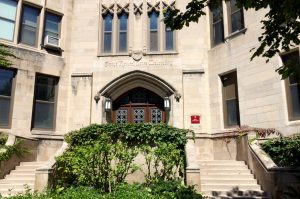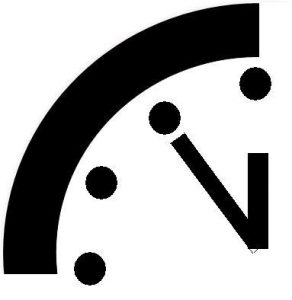“For the first time, atomic power had been released. It had been controlled and stopped,” Arthur Holly Compton declared. On December 2, 1942, Compton, a Nobel Prize-winning physicist, and 48 other Manhattan Project scientists and workers witnessed Chicago Pile-1 (CP-1), the first controlled, self-sustained nuclear chain reaction, go critical under Stagg Field at the University of Chicago.
This year marks the 75th anniversary of this landmark event that ushered in the Atomic Age. The Atomic Heritage Foundation (AHF) has produced a new “Ranger in Your Pocket” online program on the University of Chicago’s role in the Manhattan Project, the top-secret effort to produce an atomic bomb during World War II. The program features thirty audio/visual vignettes. First-hand accounts from Compton and many other Manhattan Project participants illuminate the history of the University’s Metallurgical Laboratory, or “Met Lab,” and its legacy today.
“The Manhattan Project National Historical Park was established in 2015 at three sites: Los Alamos, NM, Hanford, WA, and Oak Ridge, TN,” explains Cynthia C. Kelly, President of the Atomic Heritage Foundation. “While the University of Chicago is not an official site, the work at the top-secret Metallurgical Laboratory was critical to the Manhattan Project’s success.”
In 1942, the University of Chicago was selected for an important role: to design the world’s first nuclear reactors to produce plutonium, one of the key ingredients of an atomic bomb. The Met Lab was responsible for designing a viable method for plutonium production and provided the blueprints for the pilot and full-scale reactors that were built at Oak Ridge, TN and Hanford, WA. About 2,000 people worked at the Met Lab during the war, including physicists, chemists, engineers, machinists, and support staff. They collaborated on the project with industry leaders, especially members of the DuPont Corporation who built the reactors at Oak Ridge and Hanford.
The name “Met Lab” was meant to disguise the true nature of the work on campus. As University of Chicago physicist Peter Vandervoort explains, “The ‘Met Lab’ was a cover. It would not have done to have called it the “nuclear research lab.” It would have been a giveaway.”
 The program highlights several buildings on campus where Manhattan Project employees worked and path-breaking scientific discoveries took place. Prominent scientists, including Compton, Enrico Fermi, and Leo Szilard, had their offices at Ryerson Laboratory and Eckhart Hall. Glenn Seaborg and his colleagues synthesized plutonium at the George Herbert Jones Laboratory (right). Room 405 of Jones Laboratory, where Seaborg’s team isolated and weighed a sample of plutonium for the first time in 1942, is now a National Historic Landmark. “It was a very small room. It was only about seven or eight feet wide and maybe ten feet long,” Seaborg remembered.
The program highlights several buildings on campus where Manhattan Project employees worked and path-breaking scientific discoveries took place. Prominent scientists, including Compton, Enrico Fermi, and Leo Szilard, had their offices at Ryerson Laboratory and Eckhart Hall. Glenn Seaborg and his colleagues synthesized plutonium at the George Herbert Jones Laboratory (right). Room 405 of Jones Laboratory, where Seaborg’s team isolated and weighed a sample of plutonium for the first time in 1942, is now a National Historic Landmark. “It was a very small room. It was only about seven or eight feet wide and maybe ten feet long,” Seaborg remembered.
Recollections from Chicago Pile-1 participants convey the high stakes of the historic experiment. At CP-1, Fermi and his colleagues successfully proved that humans could initiate and control a nuclear chain reaction. Physicist Leona Marshall Libby, the only woman present, remembered participants’ relief when the experiment was over. “Eugene Wigner showed up with a flask of Chianti. There was no toast, nothing, no remarks. Nothing very dramatic, really: the most effective kind of drama probably at that point.” Today, Henry Moore’s bronze sculpture “Nuclear Energy” (below, left) marks the CP-1 site.
 Despite the military’s best efforts, security breaches did take place. Abe Krash, the editor of the Chicago Maroon, the University of Chicago’s student newspaper, ran into trouble after the Maroon printed a profile of Compton that mentioned his work on atomic energy. “They were concerned that enemy agents might get a clue as to what was going on at the university,” Krash remembers. “I thought this was, frankly, kind of preposterous. You would see Enrico Fermi, Leo Szilard, some of the most distinguished physicists in the world, having lunch. Obviously, they were not there engaged in research on the Canterbury Tales!”
Despite the military’s best efforts, security breaches did take place. Abe Krash, the editor of the Chicago Maroon, the University of Chicago’s student newspaper, ran into trouble after the Maroon printed a profile of Compton that mentioned his work on atomic energy. “They were concerned that enemy agents might get a clue as to what was going on at the university,” Krash remembers. “I thought this was, frankly, kind of preposterous. You would see Enrico Fermi, Leo Szilard, some of the most distinguished physicists in the world, having lunch. Obviously, they were not there engaged in research on the Canterbury Tales!”
The program highlights the Chicago Met Lab’s legacies for science and society today. Distinguished chemist Isabella Karle describes her laboratory’s efforts to protect workers from radiation exposure. Veteran James Schoke recalls how the Met Lab’s innovations led to the growth of the nucleonics industry and peaceful uses of radioactive isotopes in medicine and industrial applications.
Met Lab scientists also played a leading role in warning the public about the dangers of nuclear weapons and advocating for civilian control of atomic energy. In 1945, Leo Szilard drafted a petition, signed by a number of Met Lab scientists, to President Truman that sought to avert the use of atomic weapons against Japanese cities. Truman never received the petition.
After the bombings of Hiroshima and Nagasaki, several Met Lab scientists took the lead in establishing the influential journal The Bulletin of the Atomic Scientists. “What our founders understood was that science was advancing so quickly,” explains the Bulletin’s executive director, Rachel Bronson. “They understood that if we could manage the risks presented by science, we could accrue the benefits. But if we just enjoyed the benefits, it was going to a very dangerous and really unhealthy planet.” Seventy years later, through its articles and iconic “Doomsday Clock,” (below, right), the Bulletin continues to play an important role in warning the public about the dangers posed by nuclear weapons, climate change and other threats.
“Ranger in Your Pocket: The University of Chicago” will be available for the University of Chicago’s commemoration of the 75th anniversary of CP-1 on December 2, 1942. The program also complements the “Turn Back the Clock” exhibit on the Bulletin’s history currently on display at Chicago’s Museum of Science and Industry. AHF hopes to expand the program in the future to feature other Manhattan Project sites in Chicago, including Arthur Compton and Enrico Fermi’s homes in the Hyde Park neighborhood, and address the history of Argonne National Laboratory.
Visitors to the sites of the Manhattan Project National Historical Park will be able to use their smartphones and tablets to access the “Ranger” program. The Chicago program will help connect the dots to Los Alamos, Hanford and Oak Ridge and underscore the national scale and ambition of the atomic bomb project.
This project has been funded in part by a grant from the Johanna Favrot Fund for Historic Preservation of the National Trust for Historic Preservation. AHF is very grateful to James Schoke and Dieter Gruen for their generous support for the program. Special thanks to the Hyde Park Historical Society and the Bulletin of the Atomic Scientists for their partnership in exploring the Chicago Met Lab’s history and legacy today. As physicist Henry Frisch argues in one of the vignettes, “Chicago played an immensely important part in every aspect of the nuclear story. And the story is not over yet.”





![Chicago Pile-1 reunion, December 2, 1946. Photo courtesy of the University of Chicago Photographic Archive, [apf3-00232], Special Collections Research Center, University of Chicago Library.](https://ahf.nuclearmuseum.org/wp-content/uploads/2016/11/Met Lab CP-1 Group_0-scaled.jpg)